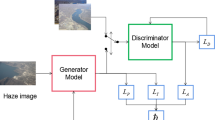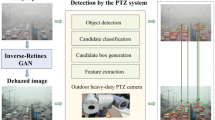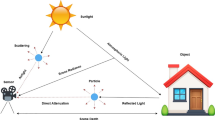Abstract
Image dehazing is a fundamental problem in computer vision. However, GT images for supervised dehazing network training are virtually impossible to obtain in the real world. Therefore, unsupervised image dehazing is of great significance. In this paper, a Cycle Generative Adversarial Network (Cycle-GAN) based on the Homology Isomerism Discriminator (HID)-assisted Detail Generation Module (DGM) is proposed to achieve image dehazing under unsupervised training. In order to enable the generator to recover the details of the entire image, especially in images with complex structures, DGM is developed to boost the details performance of the output dehazing results. Then, HID is proposed to boost dehazing performance based on heterogeneous features and Channel-Spatial Attention (CSA) and complement DGM by varied guidance to the generator. Next, the loss functions are updated according to the image dehazing task based on Cycle-GAN under unsupervised learning. Finally, the experimental results under ablation study and comparison to state-of-the-art demonstrate that the proposed method has attractive results in both visual experience and quantitative metrics under various datasets.









Similar content being viewed by others
Explore related subjects
Discover the latest articles, news and stories from top researchers in related subjects.Data availability
The O-haze, Dense-Haze, NH-HAZE datasets analyzed during the current study are respectively available at https://data.vision.ee.ethz.ch/cvl/ntire18//o-haze/, https://data.vision.ee.ethz.ch/cvl/ntire19//dense-haze/, https://data.vision.ee.ethz.ch/cvl/ntire20/nh-haze/.
References
Abdulkareem K, Arbaiy N, Zaidan AA et al (2020) A new standardisation and selection framework for real-time image dehazing algorithms from multi-foggy scenes based on fuzzy Delphi and hybrid multi-criteria decision analysis methods. Neural Comput Appl 33(4):1029–1054
Shi ZH, Feng YN, Zhao MH et al (2020) A joint deep neural networks-based method for single nighttime rainy image enhancement. Neural Comput Appl 32(7):1913–1926
Zhang XQ, Wang T, Luo WH (2021) Multi-level fusion and attention-guided CNN for image Dehazing. IEEE Trans Circuits Syst Video Technol 31(11):4162–4173
Choi LK, You J, Bovik AC (2015) Referenceless prediction of perceptual fog density and perceptual image defogging. IEEE Trans Image Process 24(11):3888–4390
Galdran A, Vazquez-Corral J, Pardo D et al (2017) Fusion-based variational image dehazing. IEEE Signal Process Lett 24(2):151–155
Lian XH, Pang YW, Yang AP (2018) Learning intensity and detail mapping parameters for dehazing. Multimed Tools Appl 77(12):15695–15720
Mathur M, Goel N (2021) Enhancement algorithm for high visibility of underwater images. IET Image Proc. https://doi.org/10.1049/ipr2.12210
He KM, Sun J, Tang XO (2011) Single image haze removal using dark channel prior. IEEE Trans Pattern Anal Mach Intell 33(12):2341–2353
Berman D, Treibitz T and Avidan S (2016) Non-local image dehazing. In: IEEE conference on computer vision and pattern recognition (CVPR), pp 1674–1682
Wang WC, Yuan XH, Wu XJ et al (2017) Fast image dehazing method based on linear transformation. IEEE Trans Multimed 19(6):1142–1155
Yang Y, Liu C (2021) Single image dehazing using elliptic curve scattering model. SIViP. https://doi.org/10.1007/s11760-021-01876-8
Li BY, Peng XL, Wang ZY et al. (2017) AOD-Net: all-in-one dehazing network. In: IEEE international conference on computer vision, pp 4770–4778
Cai BL, Xu XM, Jia K et al (2016) DehazeNet: an end-to-end system for single image haze removal. IEEE Trans Image Process 25(11):5187–5198
Fahim M, Jung HY (2021) Single image dehazing using end-to-end deep-dehaze network. Electronics 10(7)
Zhang SD, He FZ, Ren WQ (2020) NLDN: non-local dehazing network for dense haze removal. Neurocomputing 410:363–373
Zhang SD, He FZ (2019) DRCDN: learning deep residual convolutional dehazing networks. Visual Computer 36(9):1797–1808
Pang YW, Xie J, Li XL (2019) Visual haze removal by a unified generative adversarial network. IEEE Trans Circuits Syst Video Technol 29(11):3211–3221
Deniz E, Anil G and Hazim K (2018) Cycle-Dehaze: enhanced CycleGAN for single image dehazing. In: 2018 IEEE/CVF conference on computer vision and pattern recognition workshops, pp 938–946
Park J, Han DK, Ko H (2020) Fusion of heterogeneous adversarial networks for single image dehazing. IEEE Trans Image Process 29:4721–4732
Sun ZY, Zhang YF, Bao FX et al (2021) ICycleGAN: single image dehazing based on iterative dehazing model and CycleGAN. Comput Vis Image Underst 203:103133
Chen JH, Wu C, Chen H (2020) Unsupervised dark-channel attention-guided CycleGAN for single-image dehazing. Sensors 20(21):6000
Golts A, Freedman D, Elad M (2020) Unsupervised single image dehazing using dark channel prior loss. IEEE Trans Image Process 29:2692–2701
Goodfellow IJ, Pouget-Abadie J, Mirza M (2014) Generative adversarial nets. Adv Neural Inform Process Syst 27:2672–2680
Zhu JY, Park T, Isola P (2017) Unpaired image-to-image translation using cycle-consistent adversarial networks. In: IEEE international conference on computer vision, pp 2242–2251
Kingma D, Ba J (2014) Adam: a method for stochastic optimization. In: International conference on learning representations. ISSN 09252312. https://doi.org/10.1145/1830483.1830503. URL: http://arxiv.org/abs/1412.6980
Mittal A, Soundararajan R, Bovik AC (2013) Making a completely blind image quality analyzer. IEEE Signal Process Lett 20(3):209–212
Girod B (1993) What’s wrong with mean-squared error. In: Watson AB (ed) Digital images and human vision. MIT Press, Cambridge, MA, pp 207–220
Wang Z, Bovik AC, Sheikh HR et al (2004) Image quality assessment: from error visibility to structural similarity. IEEE Trans Image Process 13(4):600–612
Thanh LT, Thanh DNH, Hue NM et al (2019) Single image dehazing based on adaptive histogram equalization and linearization of gamma correction. In: Proceedings of 2019 25th Asia-Pacific conference on communications (APCC), pp 36–40
Liu XH, Ma YR, Shi ZH et al (2019) GridDehazeNet: attention-based multi-scale network for image dehazing. In: IEEE international conference on computer vision, pp 7313–7322
Dong H, Pan JS, Xiang L et al (2020) Multi-scale boosted dehazing network with dense feature fusion. In: IEEE conference on computer vision and pattern recognition
Galdran A (2018) Image dehazing by artificial multiple-exposure image fusion. Signal Process 149:135–147
Li BY, Guo YB, Gu SH et al (2021) You only look yourself: unsupervised and untrained single image dehazing neural network. Int J Comp Vision 129(5):1754–1767
Chen ZY, Wang YC, Yang Y et al. (2021) PSD: principled synthetic-to-real dehazing guided by physical priors. In: 2021 IEEE/CVF conference on computer vision and pattern recognition, pp 7176–7185
Zhou XZ, Su WJ, Lu LW et al. (2020) Deformable DETR:deformable transformers for end-to-end object detection. In: International conference on learning representations, URL: https://arxiv.org/abs/2010.04159
Funding
Key R&D program of Jiangsu Province, BE2021679, Tao Zhang.
Author information
Authors and Affiliations
Corresponding author
Ethics declarations
Conflict of interest
The authors declare that they have no conflict of interest.
Additional information
Publisher's Note
Springer Nature remains neutral with regard to jurisdictional claims in published maps and institutional affiliations.
Rights and permissions
Springer Nature or its licensor (e.g. a society or other partner) holds exclusive rights to this article under a publishing agreement with the author(s) or other rightsholder(s); author self-archiving of the accepted manuscript version of this article is solely governed by the terms of such publishing agreement and applicable law.
About this article
Cite this article
Liu, X., Zhang, T. & Zhang, J. Toward visual quality enhancement of dehazing effect with improved Cycle-GAN. Neural Comput & Applic 35, 5277–5290 (2023). https://doi.org/10.1007/s00521-022-07964-1
Received:
Accepted:
Published:
Issue Date:
DOI: https://doi.org/10.1007/s00521-022-07964-1




